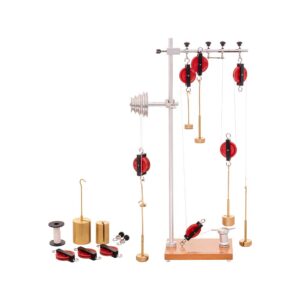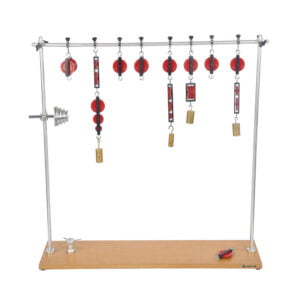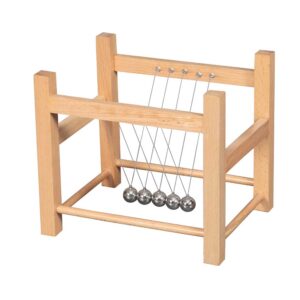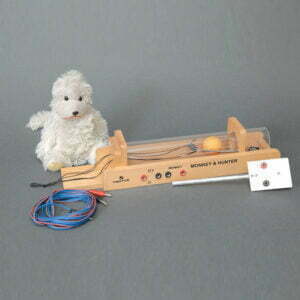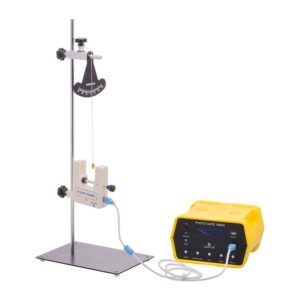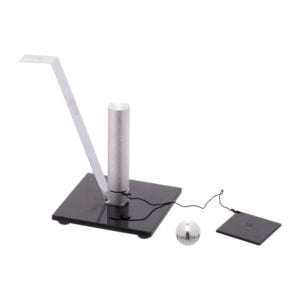Mechanics
-
Mechanics
Wheel and Axle
13 cm diameter molded wheel contains 4 grooves of different diameters in the ratios 1, 3, 5 & 7. The grooves are wide and flat bottomed ensuring an exact diameter for each groove, each comes with a small hole to retain the cord. The back of the wheel is hollow to minimize the mass and inertia. Wheel is attached to a 14 cm long rod.
PH10400 -
Mechanics
Student Pulley Set
Used to demonstrate the concepts of force and mechanical equilibrium. Contains a polished wooden base with a capstan mounted at one end and screw eye for hanging pulleys at the other, 24″ vertical support rod, 8″ crossbar with clamp, 8 single pulleys, 2 double pulleys, wheel and axle, 6 pulley clamps, 90° clamp, 9 hooked masses ranging from 10 to 1,000 g, pulley cord, and instructions.
PH10401 -
Mechanics
Pulley Demonstration Set
The Pulley Demonstration Set is designed to illustrate the working principle of simple machines. From the wheels on a bicycle to the gears in a car, the Pulley Demonstration System helps explain how things work. It helps student to understand the concepts of the mechanical advantage, the efficiency of fixed and moveable pulleys etc. Students perform quantitative experiments on fixed and moveable pulleys, trains of fixed and moveable pulleys, the wheel and axle and the capstan etc.
The set includes:
- Wooden base includes Size – 81 x 20 cm. capstans, sockets (2) and an eye hook.
- Rods : 3 (Dia. – 12.5 mm x L- 81 cm).
- Collars with hook: 8
- Right-angled clamps : 3
- Wheel axle: 1
- Bar for tightening vertical rods: 1
- Masses: Slotted brass weights. 2×10 gm, 2×20 gm 2×50 gm, 4×100 gm, 4×200 gm, 1×500 gm Total 15 weights.
- Weight hangers: Brass hangers 5×50 gm, 1×20 gm, 1x 10 gm.
PH10402 -
Mechanics
Projectile Apparatus
(Falling Body Apparatus) Showing that horizontal and vertical motions are independent of each other. Consists of a wooden block 190 x 58 x 30 mm approx. with a pivoted L-section spring loaded metal launching bar with a trigger catch. On releasing the catch, one steel ball drops vertically while the other is projected horizontally, both hitting the floor at the same time. Supplied with 2 steel balls with storage recess in the block.
PH10405 -
-
-
Mechanics
Projectile Launcher
For exploring the projectile motion and trajectories. With a release latch that can be adjusted and locked in any desired setting, Supplied with two drilled balls, attached protractor and plumb bob for determination of angle of inclination. Includes a clamp to fasten the apparatus to a tabletop. With Instructions.
PH10412 -
Mechanics
Second Law of Motion Apparatus
To demonstrate the Second Law of Motion simply and accurately, two identical balls-one drilled, and the other solid is used. When the release lever is triggered, the internal spring accelerates one ball and releases the other, showing that two balls dropped from the same height hit the ground at the same time even though one is traveling forward when the balls are released. Support stand and clamp required, but not included. With instructions.
PH10415 -
Mechanics
Energy Transformation Balls
Demonstrates conversion of kinetic energy into heat and sound energy during a collision. Consists of a pair of heavy steel balls. When the balls strike against each other with a piece of paper between the balls, the heat causes a hole to appear in the paper. The kinetic energy of the balls upon collision is converted to heat which is sufficient to burn a hole in the paper. With instructions.
PH10416 -
Mechanics
Pendulum Waves
In this apparatus, you will use the laws of simple pendulum motion to create a pendulum wave apparatus: a device where many pendulums of different lengths, and therefore different periods, start swinging at the same time. As they move in and out of sync, the pendulums create a sequence of cycling visual wave patterns.
PH10420 -
Mechanics
Ballistic Pendulum Apparatus
To demonstrate the laws of conservation of momentum and trajectory. Features a nylon block pendulum with tapered rubber insert, leveling and adjusting screws on both pendulum and base, and a rubber bumper to prevent damage on impact. Unit contains a scale marked in degrees for recording the height and is registered by a counter-weighted needle that remains in place at the height of the pendulum arc. With instructions.
PH10422 -
Mechanics
Supertek Monkey & Hunter Demonstration
This apparatus illustrates the effect of gravity on the projectile motion. An elastic-powered gun is supported from a battery-operated small electromagnet. It fires ping-pong bullet balls at a model monkey. When the projectile is fired, the electromagnetic circuit breaks. The trajectory is easily visible. Both monkey and bullet fall at the same rate and the bullet always hits the monkey regardless of how far away the monkey is. This proves that the horizontal and vertical motions are independent of each other. This unit includes a table clamp mounting plate and it may also be used as a trajectory apparatus. Requires support stand and low voltage battery, which is not provided with the apparatus.
PH10424 -
Mechanics
Pendulum Demonstration
This setup clearly demonstrates simple harmonic motion and the conservation of energy. In simple harmonic motion, pendulum swings evenly from side to side. Use photogate timer to accurately measure the period of the pendulum or the speed of the pendulum bob at the bottom of the swing. The length of the string can be adjusted to measure the change in period. Also see the effect of change in mass on the period. Two pendulum bobs are provided. Photogate Timer is not included.
PH10426 -
Mechanics
Rotational Motion Apparatus
Explore the relationship between linear (tangential) and angular velocity with this setup. A DC-driven motor produces various rotational velocity at various distances from the motor. Different radii are drawn on the disk and pegs can be positioned at specific radii. A photogate may be attached as well, so the time of one rotation is easily measured. Students will then make measurements to calculate the angular velocity, which will be constant for a given motor speed independent of position. However, the tangential velocity will vary based on the radius of the circular path. Kit includes a rotational table, ruler and calipers. Required but not included are a 6 V power supply and a photogate system.
PH10428 -
Mechanics
Inertia Apparatus
Demonstrate the principle of inertia. Comprises an aluminum rod mounted on a plastic base. Rod has a recessed top to take the spherical ball. When striker is pulled back and released the card square is propelled, but the ball unaffected and falls into the recess. Supplied complete with spherical ball and card square.
PH10512


